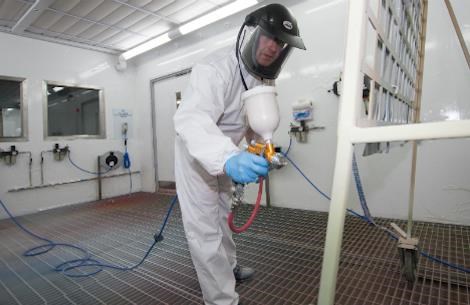PPG Expands Aerospace Coatings Development, Capabilities at UK Facility
$2 million investment supports installation of advanced-technology equipment for evaluating paint characteristics.

PPG has expanded development and technical-service capabilities for aerospace and military coatings at its Shildon, England, facility with a $2 million investment supporting installation of advanced-technology equipment for evaluating paint characteristics. Environmentally controlled spray booths and a suite of complementary rooms now enable the PPG site to streamline new-product launches and produce more-exact color matches.
One paint spray booth, which can house an aircraft section or small military vehicle, provides variable temperature and humidity settings for product development and training. A second paint spray booth, which maintains constant temperature and relative humidity settings, is designed for applying coatings to panels for customer color-match requests. An expanded testing laboratory has a dedicated color-mixing area and constant temperature and humidity settings. New sanding, drying and oven rooms afford the full range of application processing from preparation to drying in controlled environments.
According to Peter Wind, PPG technical manager, the aerospace industry is seeing increased demand for custom color as well as an accelerating pace for commercializing new coatings technologies, and the new capabilities at the Shildon facility strengthen PPG’s responsiveness to these trends.
“With color being used more in airline liveries and on business aircraft, PPG customers will be able to see more precisely how we can make their vision a reality,” Wind said.
“PPG aerospace and military coatings are designed for global application and service,” he added. “These new capabilities enable us to simulate different environmental conditions that could be encountered by our customers anywhere in the world from Dubai, where summers are hot and dry, to humid Singapore and even Russia, where a maintenance and repair operation might apply our products in damp, cold conditions. As we develop coatings that have new characteristics, we will be able to streamline their launch.”
The two paint spray booths and a viewing gallery are located in a two-story, 3,400-square-foot addition, while the testing laboratory and related rooms occupy the former spray booth space.
The Shildon facility, which has been in operation since 1967, also produces aerospace sealants and operates an application support center. It has nearly 200 employees.
PPG’s global aerospace business (ppgaerospace.com) offers coatings, sealants, transparencies, packaging and application systems, and transparent armor, as well as chemical management and other services.
Related Content
-
NASF/AESF Foundation Research Project #120: Electrochemical Destruction of Perfluorooctanesulfonate in Electroplating Wastewaters – January – December 2023
This NASF-AESF Foundation research project report covers quarterly reporting for the year 2023 at the University of Illinois at Chicago. The objective of this work is to utilize a cost-effective reactive electrochemical membrane (REM) for the removal of PFAS from synthetic electroplating wastewater. Discussed here are the oxidation of PFOA with three different catalysts, development of a method for detecting PFAS, as well as work on 6:2-fluorotelomersulfonic acid (6:2 FTS) and electrodeposited bismuth/tin oxide catalysts.
-
Explore Cleaning Chemistry, Metal Finishing Applications and Wastewater Treatment Solutions
Hubbard-Hall Celebrating 175 years of excellence, Hubbard-Hall presents chemistry and equipment.
-
NASF/AESF Foundation Research Project #122: Electrochemical Approaches to Treatment of PFAS in Plating Wastewater - 12th Quarterly Report
This NASF-AESF Foundation research project report covers the 12th quarter of project work (October – December 2023) at the University of Georgia. In our previous report, we described our work on performance and effect of surface fluorinated Ti4O7 anodes on PFAS degradation in reactive electrochemical membrane (REM) mode. This quarter, our experiments involved utilizing porous Ti4O7 plates serving both as anodes and membranes. Tests compared pristine and F-18.6 Ti4O7 anodes at current densities of 10 mA/cm2 and 40 mA/cm2. This 12th quarterly report discusses the mechanisms of the effects on EO performance by anode surface fluorination.















